This article was originally published in Quilting Quarterly magazine, Summer 2009
See also Starting with Color
Continue with Color
©2009 Ellen Lindner
When using color, just as in cooking, it’s the combination of ingredients that’s important. In the last issue, the most common color combination, complementary, was discussed. While a complementary color scheme uses colors that are totally different, the second most popular way to combine colors is to choose ones that are alike. Since these colors have similar locations on the color wheel, this is very easy to do; just choose 3-5 colors that are immediate neighbors.

As an example, Harbor Piece, below,uses the 4 similar colors shown above.
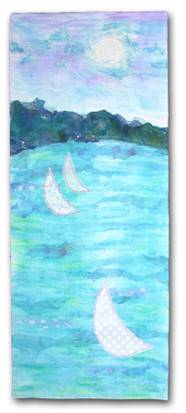
(Remember that each color swatch represents an entire color family. In this case, the selection includes a variety of values, as well as fabrics that vary in their brightness.) Because these colors are so similar, a combination of both dark and light fabrics is needed to provide sufficient contrast.
Side note: the artistic term for an arrangement of similar colors is analogous. It comes from the same root from which we get the word analogy. (Pronunciation note: analogous has a hard G in it, rather than the J sound found in analogy.)
The paper collage, Brown Cruciform, below, also has a similar color scheme. It’s easy to identify some dull yellow, orange, and red, which are neighbors on the color wheel. But what about the brown and tan colors? They are actually dark versions of yellow-orange and orange. Therefore, this piece has a similar color scheme of five colors: yellow, yellow-orange, red, red-orange, and red.
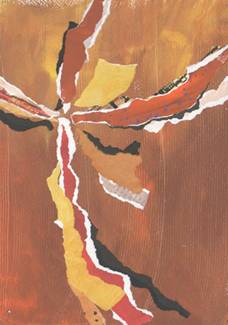
Notice that this collage has strong value contrast. Without the use of white and black, the similarity of these colors would tend to blend together, and the design would be much less visible.
Side note: Referencing the back side of a commercial artist’s color wheel makes it possible to identify the families of various browns.
Using similar colors is a good way to expand upon a monochromatic (one color) combination. Whispered Prayers, below, demonstrates this. At first glance, it appears to be just one color: fuchsia (or red-violet.) On closer examination, red and violet can also be seen. On the color wheel, they lie on either side of red-violet. Adding them to the color recipe adds interest.
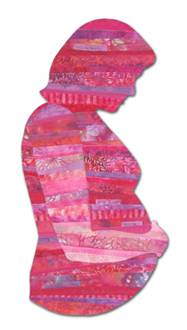
As we’ve seen, the location of colors on the wheel defines both complementary and similar color combinations. The same is true for a triad scheme, which uses three colors spaced evenly around the color wheel. The primary colors are one example.
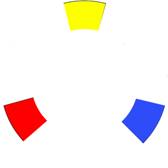
Variable Star, below, uses them, in toned down versions.
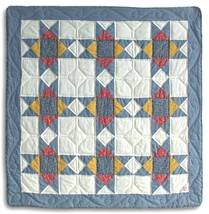
The secondary colors create another triad combination.
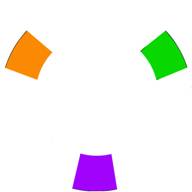
Soft versions are used in QSDS Souvenir, below.
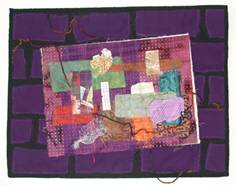
Notice that both of these triad examples have one dominant color, which works well. There are two more triad combinations. Check your color wheel and see if you can identify them.
Andrew’s Quilt, below, was made by Valerie Strickland. What color do you think is the most important?

That was a little bit of a trick question, because the most important color is white, a “non-color.” White, like gray and black, is a neutral. These neutrals are considered almost non-colors, and they’re not included on the color wheel. Their name tells you how they affect the color combinations: they don’t. They have neutral affect on the color balance.
However, they often have a huge impact on value contrast. This is one of the most important aspects of neutrals. For instance, in this quilt, white is extremely important in defining the design. It separates the strong colors, and provides a visual rest from the other colors. These are the two most common tasks performed by neutrals.
Exactly which colors are considered neutral? Purists answer “black, white, and all values of gray”. However, most authors also include beige. In the quilting world, white and cream have long been the neutrals of choice. However, black is now used quite frequently, especially with bright colors.
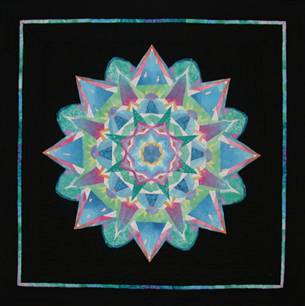
Cut Glass, above, shows how using black makes the other colors glow, almost like a stained glass window effect. (Amish quilts very effectively use black in this way.) It’s not just black that creates this luminous quality. And it’s not just the lovely pastel colors. It’s the combination of the two. ALL color decisions rely upon the mixture of ingredients.
In the beach photo below, what’s the first thing you notice?

Was it the orange umbrella on the right? That’s because it’s the brightest element. Bright, intense colors will always attract more attention than dull ones.
Looking at the image below, we see that the color wheel version of orange is very pure and bright. This changes when white, gray, or black are added, all of which make the color more subdued and less intense. (Note that intensity does not have to do with value, since the addition of black creates a color that is darker, but also less intense.) The overall intensity, or brightness, of the colors in your quilt is one of the main factors determining its mood.
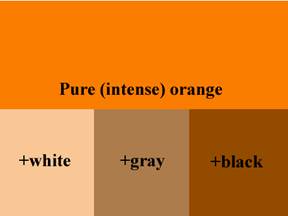
Colors of different saturations can be mixed, but this must be done carefully, because it can make or break a quilt. Think of your quilt as a choir. If you want all the fabrics to sing in harmony, you’ll need to select fabrics that have the same intensity. All bright, or all dull, for example. However, if you want an area of your quilt to stand out, like a soloist, adding a bright zinger color will do the trick. Since this will attract attention, make sure it’s used on a key design element. Because intense colors are so strong, you may only need a little. Otherwise, the soloist may appear to be singing an entirely different song!
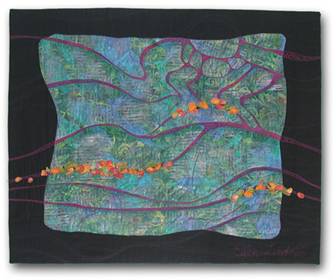
This concept can be seen in Crevice Bloom, above. The bright orange accents are the soloists. Since they’re very intense colors, they are easily noticed, even when used sparingly
In these two articles you’ve learned about the color wheel, temperature, three color schemes, neutrals, and intensity. Now, you’ve got all the ingredients you need to cook up some awesome quilts!
If you found this information useful, you may be interested in my other free articles, online classes, and e-books. Full directory
